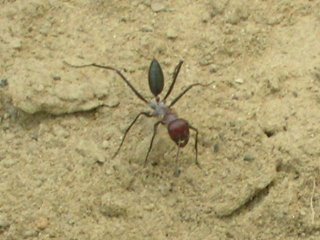My chase started sometime last year in Jahanpanah City Forest – a wild green belt that stretches about 4km, from Greater Kailash to Tughlakabad in Delhi. One day, as I was cooling off after my morning run, I noticed a little mound teeming with hyperactive ants. These fellows looked like a bunch of turbocharged Ferraris in a world of Maruti-800s.
I don’t know much about ants. My notions are limited to the many bits and bites that have come my way since childhood. I knew, for instance, that if you disturb the little black ones, they give out a smell; the big, shiny black ants in Hyderabad come with a lot of spunk and deliver painful bites but the very same fellows are quite amicable in Kerala and Delhi. The little reds are experts at finding their way into sealed packets of jam and biscuits. I knew that the red fire ants in Kerala look spectacular when they catch the morning sunlight on mossy boundary walls and overhead telephone lines. And that you should never ever mess with their leafy nests while pelting stones at mango trees.
 These ants in Jahanpanah Forest were different. Reddish brown in color, the most distinct thing about them was their long legs and a dark abdomen that always pointing skywards. You never saw them go about in groups, to bring home a dead grasshopper, for instance. Always in a tearing hurry, they never stopped by to say hello to comrades, and, when they reached home, they just dived into the darkness.
These ants in Jahanpanah Forest were different. Reddish brown in color, the most distinct thing about them was their long legs and a dark abdomen that always pointing skywards. You never saw them go about in groups, to bring home a dead grasshopper, for instance. Always in a tearing hurry, they never stopped by to say hello to comrades, and, when they reached home, they just dived into the darkness.If curiosity is a disease I seemed to be the only one who got infected in the forest. The sight of a fellow bending over an ant hole attracts curious glances first and then concern (“did you lose something there?”), amusement (“ Hey, look - that anty-guy again!”), before people learn to just leave you alone.
An old villager once came over and said that that the soil excavated by these ants had medicinal properties – it cures children of bedwetting and other ailments. I wonder how. This reminded me of my father’s description of how traditional doctors in Kerala used ants for suturing wounds. They would get black ants to bite torn skin – much like staplers - and once their mandibles clamped down, the bodies would be pinched off.
There is so little information on Indian Ants! The bookshops have lots of stuff on birds and trees, a few books on insects (Europe/America) but nothing on ants. Nothing. If you search the internet for something on Indian Ants, you get vague things like “gold digging ants of India”. Perhaps all the stuff we have is all locked up in the dusty libraries of Zoological Survey of India.
Anyway, hope was rekindled last week when an article in the Hindu featured Ajay Narendra, an ant enthusiast who was about to launch a book to fill that gaping hole in India’s ant consciousness. A couple of quick, cheery emails later, I got this diagnosis from Dr. Ajay –
"Nothing spectacular is available on indian ants, infact nothing except a 1903 publication by the fauna of british india."
"the ant you have belongs to a genus called Cataglyphis. its primarily a desert ant. The legs are exceptionally long which raises the ants body slightly above the ground to keep itself cool. its active during the hot periods of the day and primarily a scavenger. And as you mentioned they are extremely quick in walking...>30 cm per second. its distribution ranges from north india, middlle east, to North Africa. Incidentally this is one of the ants that I am currently doing my research on (see attached)."
Hallelujah!
The internet now opened up like Alibaba’s cave. According to a BBC report, scientists have recently figured out that these ants use an internal pedometer to measure exact marching distances. Wow.
___________________________________________________________________
Interesting Ant Sites -
Amazing stuff on Japanese ants:
http://ant.edb.miyakyo-u.ac.jp/INTRODUCTION/Gakken79E/title.html
Recent BBC report on Cataglyphis:
http://news.bbc.co.uk/2/hi/science/nature/5128604.stm






No comments:
Post a Comment